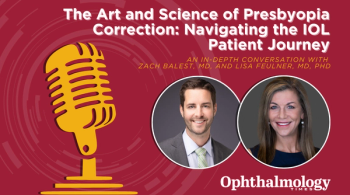
AAO: Janssen announces late-breaking data from a pair of gene therapy programs
In an announcement at the American Academy of Ophthalmology’s 2022 annual meeting at McCormick Place in Chicago, the company noted that results from Phase 1/2 MGT009 study demonstrate safety profile of investigational gene therapy botaretigene sparoparvovec (AAV-RPGR) and suggest sustained vision improvement in patients with X-linked retinitis pigmentosa.
The Janssen Pharmaceutical Companies of Johnson & Johnson announced Ftiday the primary results from the Phase 1/2 study evaluating the investigational gene therapy botaretigene sparoparvovec (formerly AAV-RPGR) in patients with the inherited retinal disease X-linked retinitis pigmentosa (XLRP) associated with the retinitis pigmentosa GTPase regulator (RPGR) gene.
The announcement was made Friday during late breaking oral presentaitons at the Retina Subspecialty Day at the American Academy of Ophthalmology’s 2022 annual meeting at McCormick Place in Chicago.
According to the company, treatment with botaretigene sparoparvovec was found to have an acceptable safety profile, and efficacy assessments in this proof-of-concept study demonstrated encouraging improvements in retinal sensitivity, visual function and functional vision.1
Janssen pointed out in a news release that these findings and additional updates, including data from a Phase 1 trial of investigational gene therapy JNJ-81201887 (JNJ-1887) for patients with geographic atrophy (GA), a late-stage and severe form of age-related macular degeneration (AMD).
XLRP is a rare condition estimated to impact one in 40,000 people globally.2,3 People with XLRP have progressive vision loss, starting in childhood with night blindness.4 Over time, they lose their peripheral vision leading to legal blindness by middle age.4 Botaretigene sparoparvovec is being investigated in collaboration with MeiraGTx Holdings plc to treat patients with XLRP caused by disease-causing variants in the eye-specific form of the RPGR (RPGR ORF15) gene.
The company also noted that through a one-time administration, botaretigene sparoparvovec is designed to deliver functional copies of the RPGR gene to counteract the loss of retinal cells with the goal of preserving and potentially restoring vision for those living with XLRP. Currently, there are no approved treatments for XLRP.4
"Individuals living with XLRP often begin to experience symptoms in childhood, and as retinal degeneration progresses toward blindness, they can start to feel a sense of hopelessness as there are no treatments to turn to," said Michel Michaelides, BS., MB, BS, MD (Res), FRCOphth, FACS, a consultant ophthalmologist, Moorfields Eye Hospital, Professor of Ophthalmology, University College London and lead investigator.‡ "These results from the MGT009 study are promising, as they represent the potential for botaretigene sparoparvovec to preserve vision and ultimately restore hope for these patients."
Moreover, the company noted that the primary endpoint of the MGT009 study (
According to Janssen, analyses of the pooled low and intermediate dose cohorts demonstrated improvement in retinal sensitivity in the treated eyes compared to untreated eyes in the randomized concurrent control arm as measured by both full-field static perimetry and microperimetry.1 An improvement in mean retinal sensitivity as measured by static perimetry in the central 10-degree area of the retina was observed at six months in the treated eyes compared to untreated eyes in the randomized concurrent control arm [in the full analysis of pooled low and intermediate doses across adults: 1.96 decibel (dB); (±95% CI: 0.59, 3.34); and in the sensitivity analysis when applying the Phase 3 criteria: 2.42 (0.91, 3.93)].1
The company also noted that as part of the study, patients performed a functional vision assessment using a
The safety profile of botaretigene sparoparvovec observed in MGT009 was consistent with previous reports.1 Botaretigene sparoparvovec demonstrated an adverse event (AE) profile that was anticipated and manageable.1 Most AEs were related to the surgical delivery procedure, were transient and resolved without intervention.1 There were no dose-limiting events.1 A total of three serious adverse events (SAEs) were observed in the overall Phase 1/2 MGT009 clinical study; two SAEs, which were previously reported, were observed in the dose-escalation phase of the study (n=10; one retinal detachment and one panuveitis in the low dose cohort), and a single additional SAE of increased intraocular pressure was observed in the dose escalation phase and resolved with treatment.1
"Without an approved treatment option available, people with XLRP are faced with the inevitable fate of going blind in the prime of life," said James List, M.D., Ph.D., Global Therapeutic Area Head, Cardiovascular, Metabolism, Retina & Pulmonary Hypertension, Janssen Research & Development, LLC. "We're in a race to save sight for these patients and are encouraged by the strength of the data that we've shared so far. We look forward to advancing the clinical development of botaretigene sparoparvovec as part of our mission to preserve and potentially restore vision for these patients."
Further sensitivity analysis was conducted on study participants by applying the Phase 3 LUMEOS (
Phase 1 Data Evaluating JNJ-1887 in Geographic Atrophy
Janssen also presented late-breaking data from a Phase 1, open-label, multicenter, dose-escalation, safety and tolerability study (
About the Phase 1/2 MGT009 Trial and Botaretigene Sparoparvovec
The Phase 1/2 MGT009 trial (
The clinical study was composed of three parts: dose-escalation, pediatric dose-confirmation and an expansion phase. In the dose escalation phase, adult patients were treated at three escalating doses of botaretigene sparoparvovec; a low (2x1011 vg/mL), an intermediate (4x1011 vg/mL), and a high (8x1011 vg/mL) dose. In the expansion phase, 42 adult male patients were randomized to either immediate treatment with one of two low or intermediate doses or an untreated concurrent control arm with deferred treatment. At six months, the untreated control arm was randomized to receive either the low or intermediate treatment doses. Botaretigene sparoparvovec was administered through subretinal delivery in only one eye. The adult patients received treatment at three doses. The pediatric cohort (n=3) was only treated with an intermediate dose of botaretigene sparoparvovec.
Botaretigene sparoparvovec has been granted Fast Track and Orphan Drug designations by the U.S. Food and Drug Administration (FDA) and PRIority MEdicines (PRIME), Advanced Therapy Medicinal Product (ATMP) and Orphan designations by the European Medicines Agency (EMA).
About the Janssen and MeiraGTx Strategic Collaboration
In January 2019, Janssen Research and Development, LLC entered into
About the Phase 1 JNJ-1887 Trial and JNJ-1887
JNJ-81201887 (JNJ-1887), formerly referred to as AAVCAGsCD59, is an investigational gene therapy for the treatment of people with geographic atrophy (GA) secondary to dry age-related macular degeneration (AMD). JNJ-1887 is designed to increase the expression of a soluble form of CD59 (sCD59) intended to protect retinal cells to slow and prevent disease progression. JNJ-1887 was evaluated in a Phase 1 clinical trial (
This Phase 1 study met its primary endpoint of safety in all doses of JNJ-1887 (n=17), with supportive efficacy measures including evaluation of GA lesion growth rates, which showed a continual decline in lesion growth over six-month increments.
JNJ-1887 has been granted Fast Track designation by the FDA and Advanced Therapy Medicinal Product (ATMP) designation by the European Medicines Agency (EMA).
References
1 Michaelides, M et al. Ph1/2 AAV5-RPGR (Botaretigene Sparoparvovec) Gene Therapy Trial in RPGR-associated X-linked Retinitis Pigmentosa (XLRP). Abstract #30071754. Presented at the 2022 American Academy of Ophthalmology Annual Meeting.
22 Boughman JA, Conneally PM, Nance WE. Population genetic studies of retinitis pigmentosa. Am J Hum Genet. 1980;32(2):223–235.
3 Fishman GA. Retinitis pigmentosa. Genetic percentages. Arch Ophthalmol. 1978;96(5):822–826. doi:10.1001/archopht.1978.03910050428005.
4 Wang DY, Chan WM, Tam PO, et al. Gene mutations in retinitis pigmentosa and their clinical implications. Clin Chim Acta. 2005;351(1-2):5-16.
5 Cohen, MN et al. Phase 1 Study of JNJ-81201887 Gene Therapy in Geographic Atrophy (GA) Due to Age-related Macular Degeneration (AMD). Abstract #30071749. Presented at the 2022 American Academy of Ophthalmology Annual Meeting.
6 Singh RP, Patel SS, Neilsen JS, et al. Patient-, caregiver- and eye care professional-reported burden of geographic atrophy secondary to age-related macular degeneration. Am J Ophthalmic Clin Trials. 2019;2(1):1-6.
Newsletter
Don’t miss out—get Ophthalmology Times updates on the latest clinical advancements and expert interviews, straight to your inbox.














































.png)


